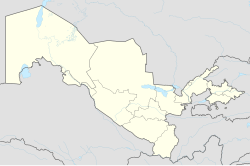 | |
| Location | At-Termeziy 29A, Termez, Uzbekistan |
|---|---|
| Coordinates | 37°14′39″N 67°16′58″E / 37.2442°N 67.2828°E |
The Archaeological Museum of Termez is a museum in the city of Termez, modern Uzbekistan. The artifacts contained in the museum are mainly linked to the Graeco-Bactrian and Kushan periods. Some artifacts, such as the seated Buddha under the Bodhi tree or head of the Kushan prince are actually copies, the original of which are located in the History Museum of Tashkent and in the Hermitage Museum in Saint-Petersburg.[1][2]
There are also scale models of the archaeological sites of Salalli Tepe, Kampyr Tepe, Khalchayan, Balalyk Tepe and Fayaz Tepe.[1][2]
A famous mural, the so-called "Princess of Tokharistan", was found at Tavka Kurgan in Shirabad.[1][2][3]
-
Greco-Buddhist frieze showing musicians, in the style of Gandhara.
-
Lion capital
-
Capital with Classical Garland bearers, 100-200 CE.
-
-
Tavka Kurgan wall painting. 5th-6th century CE.
-
Khalchayan terracotta statue.
References
- ^ a b c Ibbotson, Sophie; Lovell-Hoare, Max. Uzbekistan. Bradt Travel Guides. p. 189. ISBN 978-1-78477-017-4.
- ^ a b c Lovell-Hoare, Sophie; Lovell-Hoare, Max. Uzbekistan. Bradt Travel Guides. p. 171. ISBN 978-1-84162-461-7.
- ^ "Most striking is the fragmented mural found at Tavka Kurgan in Shirabad and entitled 'Princess of Toharistan' . It is actually believed to be a hunter , painted in rich orange , blue and white , with striking eyes preserved so well they belie their age – 1500 years old." in Uzbekistan: The Golden Road to Samarkand. Odyssey. p. 2019. ISBN 978-962-217-795-6.










